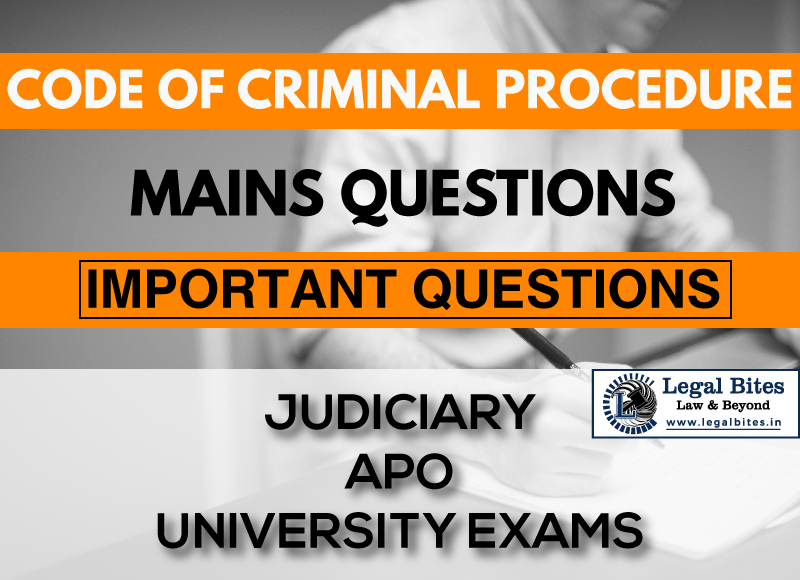Critically examine the major changes introduced by the Criminal Law (Amendment) Act, 2013... especially.....the crimes related to women.
Find the answer to the mains question only on Legal Bites.

Question: Critically examine the major changes introduced by the Criminal Law (Amendment) Act, 2013 in the provisions of Code of Criminal Procedure, 1973, especially with regard to the crimes related to women. [JJS 2018]Find the answer to the mains question only on Legal Bites. [Critically examine the major changes introduced by the Criminal Law (Amendment) Act, 2013 in the provisions of Code of Criminal Procedure, 1973, especially with regard to the crimes related to women.]AnswerThe...
Question: Critically examine the major changes introduced by the Criminal Law (Amendment) Act, 2013 in the provisions of Code of Criminal Procedure, 1973, especially with regard to the crimes related to women. [JJS 2018]
Find the answer to the mains question only on Legal Bites. [Critically examine the major changes introduced by the Criminal Law (Amendment) Act, 2013 in the provisions of Code of Criminal Procedure, 1973, especially with regard to the crimes related to women.]
Answer
The Criminal Law (Amendment) Act, 2013 was a major attempt by the legislature to introduce significant changes in the Code of Criminal Procedure, 1973. These changes were brought after the Nirbhaya rape case in an attempt to address crimes against women more rigorously and effectively.
Let us critically examine the changes brought by the 2013 Amendment, with significant emphasis on its impact and are scope of improvement in a few areas.
(A) Section 154(1) - Recording of FIR:
The 2013 amendment ensures that any information regarding offences against women like rape, or outraging modesty of a woman (Sections 354, 376, etc. of IPC) must be recorded by a woman police officer.
Suppose the victim is physically or mentally challenged. In that case, the information must be recorded by a women police officer at her residence or a place of her choice. Still, it shall be recorded in the presence of an interpreter or special educator. The same shall also be video-graphed.
The amendment above has no doubt played a key role in ensuring the sensitivity of such matter is handled properly while also ensuring the comfort of the victim during the reporting process.
However, there are infrastructural lacunae that may impede the implementation of these provisions such as due to lack of trained female police officers and appropriate resources in many regional areas.
(B) Section 164(5A) - Statement by the Victim:
The objective was to ensure the statement of the victim is recorded in the presence of a Judicial Magistrate as soon as the criminal offence is reported.
The significance of this amendment cannot be underscored as it preserves the accuracy and reliability of the testimony of the female victim. However, the only factor that can impede the smooth implementation of this provision is a delay in the judicial process or a shortage of judicial magistrates at times.
(C) Section 197(1) - Prosecution of Public Servants:
Vide the amendment in this section, an explanation was appended to Section 197(1) of CrPC indicating that prior sanction from the government is not required to start prosecution against public servants for committing sexual offences against women.
Although this is a progressive step by the legislature, the effectiveness of the same at large depends on the ability of the judiciary to function without any resistance from political or administrative/executive powers.
(D) Section 309 - Speedy Trial:
The amendment mandates that trials of such offences are completed within a specified period, ensuring expedited trials and justice for the victim of sexual offences.
(E) Section 357C - Free Medical Aid is mandatory to be provided to the victims of sexual assault:
Although the hospitals are directed to provide quick and efficient medical aid, the lack of infrastructure and medical professionals at times remains a challenge for the compliance of this provision.
Important Mains/Long Questions for Judiciary, APO & University Exams
- CRPC Mains Questions Series Part I: Important Questions
- CRPC Mains Questions Series Part II: Important Questions
- CRPC Mains Questions Series Part III: Important Questions
- CRPC Mains Questions Series Part IV: Important Questions
- CRPC Mains Questions Series Part V: Important Questions
- CRPC Mains Questions Series Part VI: Important Questions
- CRPC Mains Questions Series Part VII: Important Questions
- CRPC Mains Questions Series Part VIII: Important Questions
- CRPC Mains Questions Series Part IX: Important Questions
- CRPC Mains Questions Series Part X: Important Questions
- CRPC Mains Questions Series Part XI: Important Questions

Mayank Shekhar
Mayank is an alumnus of the prestigious Faculty of Law, Delhi University. Under his leadership, Legal Bites has been researching and developing resources through blogging, educational resources, competitions, and seminars.
